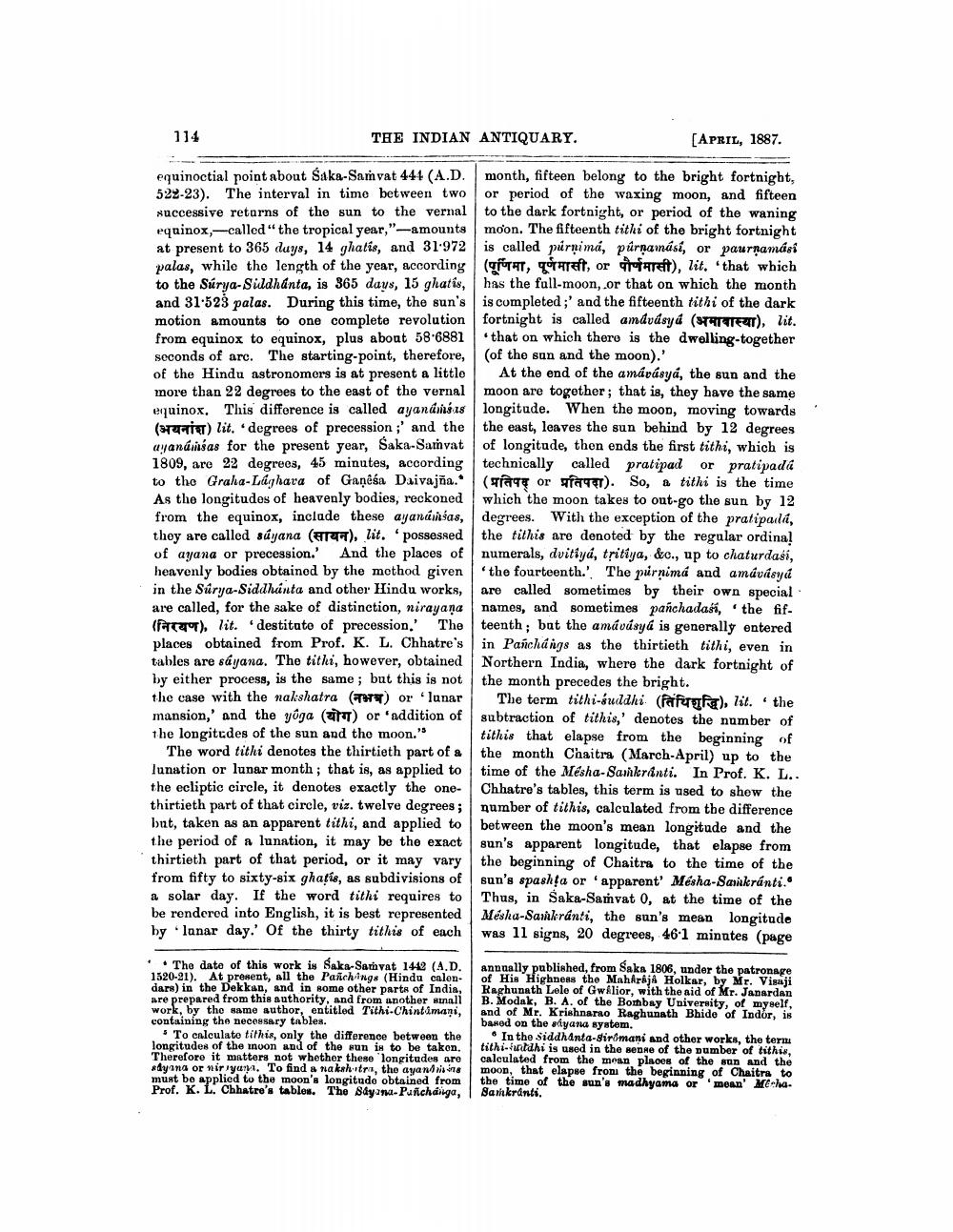________________
114
THE INDIAN ANTIQUARY.
[APRIL, 1887.
equinoctial point about Saka-Samvat 44+ (A.D. month, fifteen belong to the bright fortnight, 522-23). The interval in time between two or period of the waxing moon, and fifteen successive retorns of the sun to the vernal to the dark fortnight, or period of the waning equinox,-called the tropical year, "-amounts moon. The fifteenth tithi of the bright fortnight at present to 365 duys, 14 ghatis, and 31.972 is called purnimá, púrņamási, or paurnamási palas, while the length of the year, according (PTAT, oraret, or art), lit. that which to the Súrya-Siddhanta, is 365 days, 15 ghatis, has the fall-
mon, or that on which the month and 31.523 palas. During this time, the sun's is completed;' and the fifteenth tithi of the dark motion amounts to one complete revolution fortnight is called amdvdsyd (TATTET), lit. from equinox to equinox, plus about 58-6881 'that on which there is the dwelling together seconds of are. The starting-point, therefore, (of the sun and the moon). of the Hindu astronomers is at present a little At the end of the amápásy, the sun and the more than 22 degrees to the east of the vernal moon are together; that is, they have the same equinox. This difference is called ayandibus longitude. When the moon, moving towards (uni) lit. degrees of precession;' and the the east, leaves the sun behind by 12 degrees ayanánsas for the present year, Saka-Samvat of longitude, then ends the first tithi, which is 1809, are 22 degreos, 45 minutes, according technically called pratipad or pratipada to the Graha-Laghava of Ganesa Daivajña. (at or fam). So, tithi is the time As the longitudes of heavenly bodies, reckoned which the moon takes to out-go the sun by 12 from the equinox, include these ayanánsas, degrees. With the exception of the pratipada, they are called súyana (area), lit. possessed the tithis are denoted by the regular ordina! of ayana or precession.' And the places of numerals, dvitiya, tsitiya, &c., up to chaturdasi, heavenly bodies obtained by the mothod given the fourteenth.'. The purnima and amávásya in the Súrya-Siddhanta and other Hindu works, are called sometimes by their own special are called, for the sake of distinction, nirayana names, and sometimes pañchadas, the fif. (faraot), lit. destituto of precession. The teenth; but the amávúsyd is generally entered places obtained from Prof. K. L. Chhatre's in Panchangs as the thirtieth tithi, even in tables are sáyana. The titki, however, obtained Northern India, where the dark fortnight of by either process, is the same; but this is not the month precedes the bright. the case with the nakshatra (H) or lunar The term tithi-áuddhi (Pafcufg), lit. the mansion,' and the yoga (h) or 'addition of subtraction of tithis,' denotes the number of the longitudes of the sun and tho moon." tithis that elapse from the beginning of
The word tithi denotes the thirtieth part of a the month Chaitra (March-April) up to the Tunation or lunar month; that is, as applied to time of the Mésha-Sankranti. In Prof. K. L.. the ecliptic circle, it denotes exactly the one- Chhatre's tables, this term is used to shew the thirtieth part of that circle, viz. twelve degrees; number of tithis, calculated from the difference but, taken as an apparent tithi, and applied to between the moon's mean longitude and the the period of a lunation, it may be the exact sun's apparent longitude, that elapse from thirtieth part of that period, or it may vary the beginning of Chaitra to the time of the from fifty to sixty-six ghatís, as subdivisions of sun's spashţa or apparent' Mesha-Sankranti.. a solar day. If the word tithi requires to Thus, in Saka-Samvat 0, at the time of the be rendered into English, it is best represented Mésha-Sankranti, the sun's mean longitude by lanar day.' Of the thirty tithis of each was 11 signs, 20 degrees, 46'1 minutes (page
. . The date of this work is Saka-Samvat 1442 (A.D. 1520-91). At present, all the Panchings (Hindu calendars) in the Dekkan, and in some other parts of India, are prepared from this authority, and from another finall work, by the same author, entitled Tithi.Chintamani, containing the necessary tables.
• To calculate tithis, only the difference between the longitudes of the inoon and of the sun is to be taken. Therefore it matters not whether these longitudes are sayang or wir jy . To find a nakshatra, the ayannis 18 must be applied to the moon's longitude obtained from Prof. K. L. Chhatre's tables. The sayam-Punchinga,
annually published, from Saka 1806, under the patronage of His Highness the Maharaja Holkar, by Mr. Visaji Raghunath Lele of Gwalior, with the aid of Mr. Janardan B. Modak, B. A. of the Bombay University, of myself, and of Mr. Krishnarao Raghunath Bhide of Indor, is based on the aiyand system.
• In the siddhanta-sirimani and other works, the term tithi Funidhi is used in the sense of the number of tithis, calculated from the mean places of the sun and the moon, that elapse from the beginning of Chaitra to the time of the sun's madhyama or mean' Mesha. Sankranti




